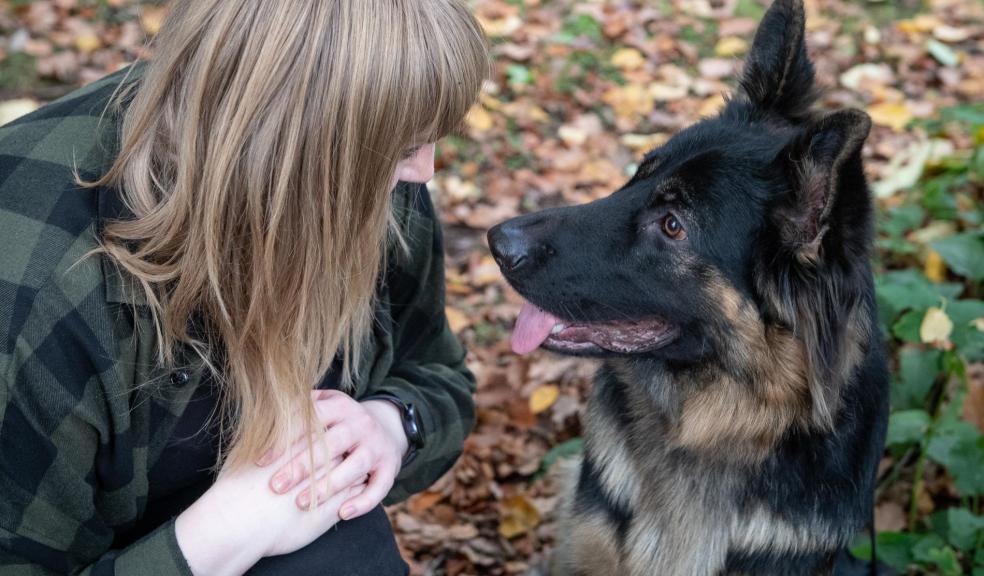
Canine Expert shares tips to understand your dog's body language
As much as we wish we could, we can't converse with our dogs the same way we do with humans, so the best way to understand them is though their emotions and body language.
Dogs mature emotionally up to the age of two and a half years so it is especially important to make sure they are understood in their key developmental stages. Bella & Duke's Natural Canine Behaviourist, Caroline Spencer has shared her top tips to help understand which emotions your dog is going through from stress and anxiety to being happy and playful.
- Happiness & Content
When your pup is happy and relaxed, they will have a level body, their head and tail will be at medium height, their jaw will be open and relaxed, and a long blink is friendly, their eyes will be squinty, and they will have a floppy tongue. Specific signs can vary between breeds but one of the easiest way to tell if your furry friend is happy is in the body tension. When happy they will have a relaxed posture and move in a relaxed manner.
- Anxious
An anxious dog tends to look away, they blink more to avoid conflict, leaning back with braced back legs. An easy way to see anxiety in your dog is by how wider their eyes, the wider they are the more stressed the dog feels.
Anxiety can stem from an array of things from meeting a new dog, having guests over or even just having a new addition put in the home. Allow your dog time and space to acclimatise and familiarise themselves in their own time, no pressure from us to accept.
3. Stress
There's a number of tell-tale signs when it comes to a stressed dogs usually in the form of pacing, panting and drooling, to name a few.
If you notice these behaviours in your dog it's best to remove them from the situation and then gradually work on small steps to help them through. Firstly, find what is causing them distress. It may be sensory overloads such as fireworks and storms or being in a car without you. Be there for them in their time of need or they'll soon become flooded with stressors that can create triggers for similar situations in the future.
4. Fearful
When our furry friends feel they are in danger they will have a variety of signs which are telling such as frequent tongue flick, whale eye (showing the whites of their eye), leant back posture, also direct eye contact and suddenly freezing still. It is increasingly important to be cautious if you notice any of these signs because a fearful dog can be one that is ready to protect itself.
5.Protective
When dogs are guarding something, be that their house or a toy they will have a side eye (nose directed towards interloper and over item of value), their ears pinned back, facing forward, lowered head, braced legs, tight shut mouth, head over their prized object, may lift a lip to present their teeth, growl and escalate if intruder gets too close. Let your dog have its space, there's no reason we should get angry or frustrated when a dog steals a biscuit off the table and not expect the same back. This does come in moderation as you should have a relationship with your pet where you can take food away without an aggressive response.
6. Playful
A dog that is ready to play will do what is called the play bow, their tongue will be floppy, lips long and mouth open, tail low, alert ears, eyes and head facing playmate.
7. Appeasement
These would be behaviours used in a situation when a younger dog is told off by an older dog. Their head will turn away and dip down, their ears will pin back slightly and quite literally walk back with their tail tucked between their legs.
Caroline Spencer Dip.AdvCanBhv, Natural Canine Behaviourist at Bella & Duke, added: "It's easy to think that you can tell how your dog communicates, we all are taught to think a wagging tail is a happy dog but that can often be misleading as it can actually be a sign of caution or even an overly confident and potentially threatening dog. We need to understand how our dogs communicate not only to build a stronger relationship with them but to notice signs of distress to take them away from any stressful situations to keep them safe. "
To be able to think clearly, they need both mental stimulation and nutritional nourishment. Dogs do learn our ways and it's important how we speak to them and what emotion we use when doing so. Respect them for who they are, their language, and their personal space. When you do this, they will also learn to respect yours.







